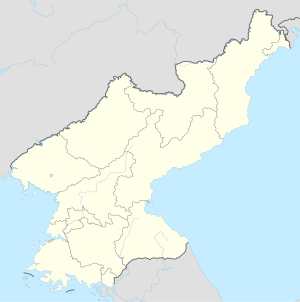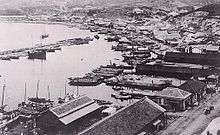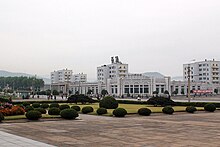Ch'ŏngjin
| Chŏngjin | |||
|---|---|---|---|
| Korean alphabet : | 청진 시 | ||
| Chinese characters : | 淸 津市 | ||
| Revised Romanization : | Cheongjin-si | ||
| McCune-Reischauer : | Ch'ŏngjin-si | ||
| Basic data | |||
| Province : | Hamgyŏng-pukto | ||
| Coordinates : | 41 ° 48 ' N , 129 ° 47' E | ||
| Residents: | 667,929 (as of 2008) | ||
| Structure: | 7 districts ( Kuyŏk ) | ||
| map | |||
|
|||
Ch'ŏngjin is a port city in North Korea with 667,929 inhabitants. It is an industrial city, transport hub and cultural center with universities , colleges , theaters and museums . The People's Republic of China and Russia have opened consulates in the city.
geography
Geographical location
The city is located on the east coast of North Korea on the Sea of Japan , 42 meters above sea level .
About 80 percent of the administrative area of Ch'ŏngjin-si, which also includes rural regions, is covered by forest. In the vicinity of the city, however, the trees have been cleared almost completely due to a lack of fuel. The coastline is 80 kilometers. The geographic coordinates are 41.78 degrees north and 129.78 degrees east.
City structure
Ch'ŏngjin-si is divided into the following seven districts:
- Ch'ŏngam-guyŏk ( 청암 구역 ; 青岩 區域 )
- P'ohang-guyŏk ( 포항 구역 ; 浦 港 區域 )
- Puyun-guyŏk ( 부윤 구역 ; 富潤 區域 )
- Ranam-guyŏk ( 라남 구역 ; 羅南 區域 )
- Sinam-guyŏk ( 신암 구역 ; 新 岩 區域 )
- Songp'yŏng-guyŏk ( 송평 구역 ; 松坪 區域 )
- Sunam-guyŏk ( 수남 구역 ; 水 南 區域 )
climate
The city is located in the temperate climate zone . The average annual temperature is 7.6 degrees Celsius and the annual rainfall is 623.4 millimeters.
The warmest month is August with an average of 21 degrees Celsius, the coldest January with an average of −6 degrees Celsius. Most of the precipitation falls between June and August with an average of 84 to 135 millimeters, and the least with five to eight millimeters between December and March.
Winters are warmer in coastal Ch'ŏngjin than in the inland regions, with frequent fog in spring and summer. On average there are 35 to 45 foggy days a year, with a maximum in June and July.
history
The area around today's city of Ch'ŏngjin, northeast Korea , was sparsely populated and poorly developed until the 20th century. This only changed with the incorporation of Korea into the Japanese Empire (1910 to 1945). During this time the city officially bore the Japanese name Seishin ( Japanese 淸 津 ). The Japanese Empire saw the region as a parade ground for the planned invasion of Manchuria , the northeast of the Republic of China . Accordingly, significant troops (19th Infantry Division of the Imperial Japanese Army ) were stationed in the city . Japan was also interested in using the region's mineral resources. Coal and ore mines were built in Musan-gun County on the border with China. To ship the raw materials, a port was set up in Seishin, which until then was an insignificant fishing village, and a large steel mill was also built nearby.
During the Korean War (1950–1953), the city suffered severe devastation. Large parts of the city were destroyed in a bomb attack by American planes on August 19, 1950. After the war, Ch'ŏngjin developed into an industrial city and a transport hub for the region.
It was a city under central government administration from 1960 to 1967 and from 1977 to 1985 . Since 1985 it has been part of the North Hamgyŏng Province and its capital. In the 1970s, at the height of the city's economic development, Ch'ŏngjin was the second largest city in North Korea with around 900,000 inhabitants . Since then, the number of inhabitants has decreased significantly. Ch'ŏngjin was particularly hard hit during the famine in North Korea in the 1990s. Several thousand people, estimated at around 20% of the population, died from starvation.
Culture and sights
The waterfalls and Mount Chilbosan are worth seeing in the vicinity of the city . Ch'ŏngjin Zoo existed until the mid- 1990s .
Economy and Infrastructure
economy
Metallurgy , mechanical engineering , chemical , textile and light industries have settled in Ch'ŏngjin . The Kim Ch'aek Iron and Steel Mill is the largest of its kind in North Korea. There are ships , locomotives and rubber produced. There is also a marine products research center in the city.
The most famous product of Ch'ŏngjin is the squid , which is known throughout North Korea and valued as a delicacy. There is a hydroelectric power station near Ch'ŏngjin , which is used to generate electricity in the region.
Hana Electronics operates a large branch here.
traffic
Ch'ŏngjin is an important traffic junction with roads and rail connections to the south of the country, to Wŏnsan and in the north-east, to the city province of Rasŏn, which is centrally administered by the government . Ch'ŏngjin has a port opened in 1908 , a marshalling yard and an airport . The Ch'ŏngjin trolleybus has been around since 1970 and the Ch'ŏngjin tram has been around since 1999 .
The Chongjin Airport is just like the Sungam Ni Airport south of the city.
education
The city has three universities and several colleges and technical schools.
Others
In Ch'ŏngjin there is a medium wave transmitter of the North Korean Ministry of Post and Telecommunications (frequency 621 kHz with 500 kW power), which broadcasts the Japanese- language program of the Voice of Korea and the program of the domestic service P'yŏngyang Pangsong ( German Radio Pyongyang ).
In the totalitarian North Korean social system, the distance between a place and the capital determines its prestige. For example, citizens who are considered politically unreliable are not allowed to live in Pyongyang . Far away in the north-east of the country, Ch'jngjin is regarded as a place of exile. Accordingly, there is a large internment camp for political prisoners on the northern outskirts .
The official North Korean historiography does not mention the role of the Japanese in the development of the city of Ch'ŏngjin and its industrial and port facilities. The development work is attributed solely to the state's founder, Kim Il-sung .
Sports
Soccer
The Chandongja Sports Club plays its home games in Chandongja Park , which has a capacity of 15,000 spectators. In 1989 they took first place in the DPR Korea League .
sons and daughters of the town
- Lee Soon-ok (born 1947), Korean human rights activist
- Shin Sang-ok (1926-2006), South Korean film producer and director
swell
- ↑ 2008 Census of Population of DPR Korea (PDF file; 1.4 MB), Central Bureau of Statistics (English).
- ↑ Central Institute for Meteorology and Geodynamics: Weather for the Democratic Republic of Korea (North) ( Memento of the original from November 4, 2011 in the Internet Archive ) Info: The archive link was automatically inserted and not yet checked. Please check the original and archive link according to the instructions and then remove this notice.
- ↑ a b c d e Barbara Demick: Nothing to Envy. Real Lives in North Korea. London : Granta, 2010. ISBN 978-1-84708-014-1 . P. 36ff.
- ↑ http://www.nkeconwatch.com/category/dprk-organizations/companies/hana-electronics-company/
Web links
- Rainer Dormels: Chongjin - city with old industry and potential to become a traffic junction , 2014 (PDF; 765 kB)
- Online slide show Chilbo-san - the mountains of the seven treasures near Ch'ŏngjin



